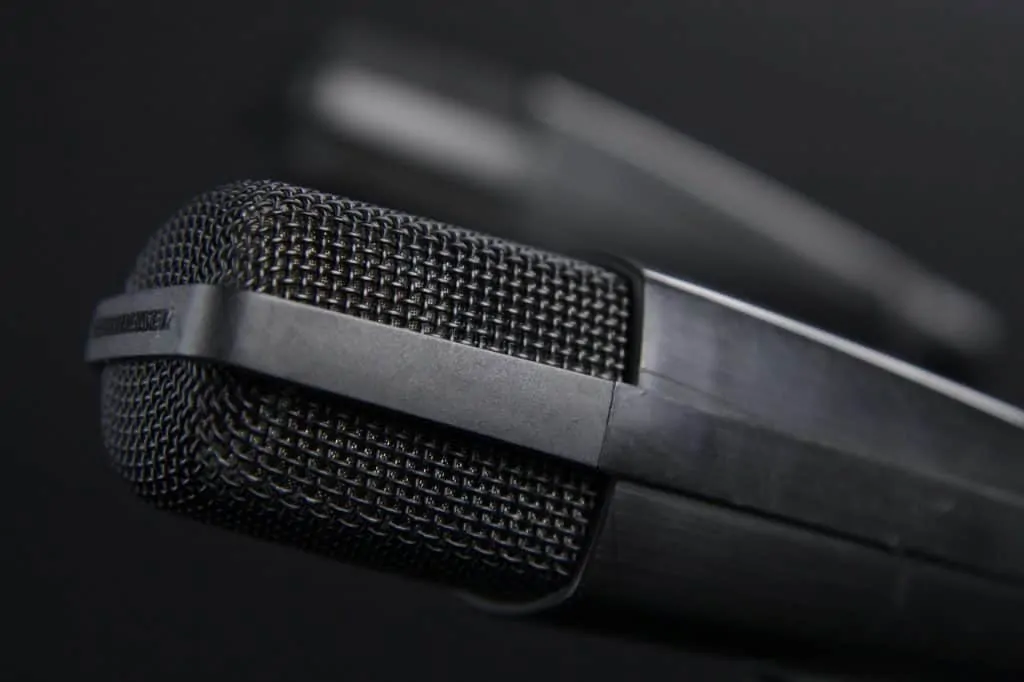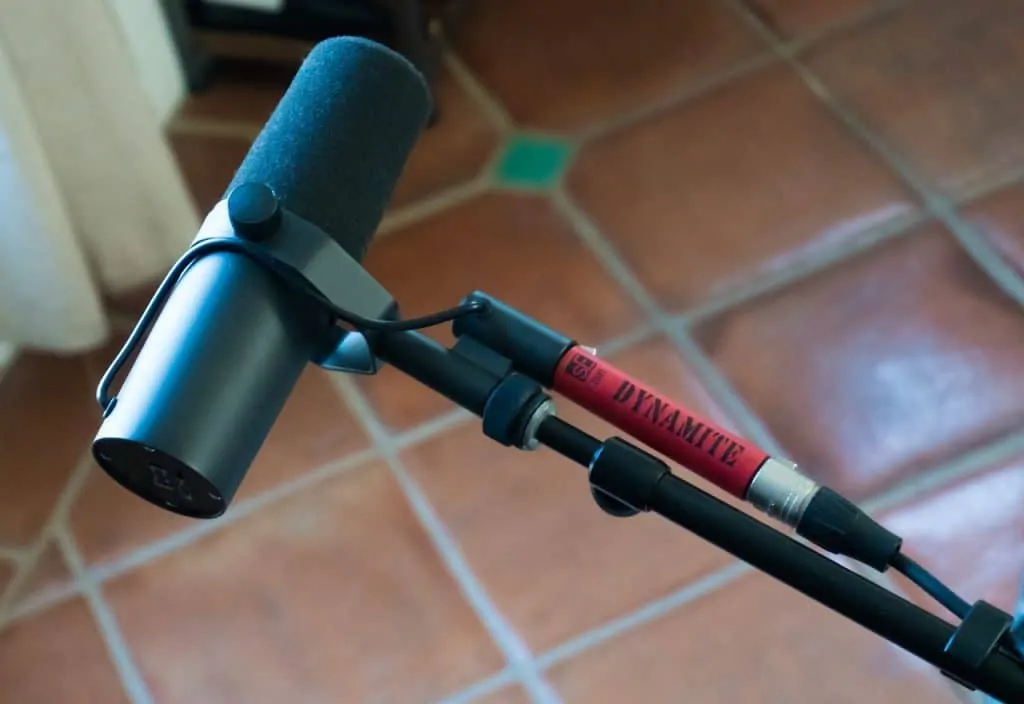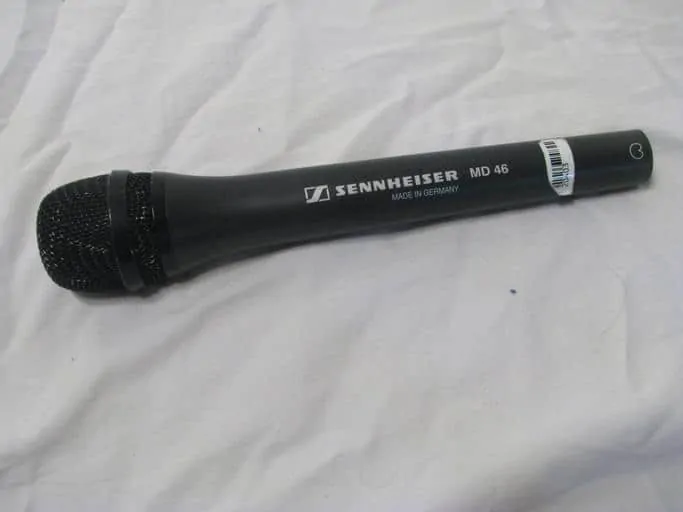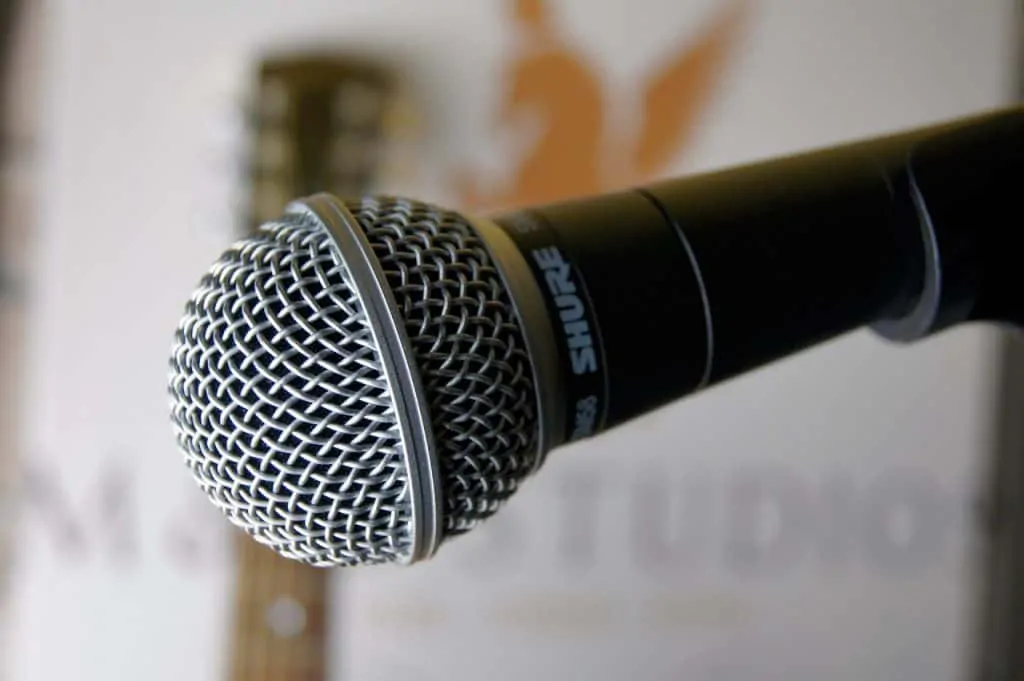Sennheiser Electronic is a german audio company known for producing top microphones and audio devices. If you’ve got a Sennheiser device on your hands, you know you have a highly reliable product.
Their lineup includes microphones, smartphone peripherals (like earbuds), headphones, professional and business applications, and more.
Today, Beginner Guitar HQ is talking about the Sennheiser e935 Dynamic Microphone, a popular choice for singers and performers on the stage. In fact, we already listed the e935 in our prior best mics for the stage list.
That’s not quite surprising, though. The e935 mic is a constant pick on every best mics list you see, condenser or not. It’s also widely available as it’s always in stock, at least on Amazon. Keep in mind Sennheiser operates in more than 50 countries, so their products have a worldwide presence.
Better yet: the price of the Sennheiser e935 is very reasonable. You’ll realize its price tag is nothing but honest.
All of that makes this mic compete against the clarity and precision of the best condenser mics you can buy right now. And we’re going to understand why and compare this to the popular Shure SM58 dynamic budget mic.
Sennheiser was founded in 1945 by Dr. Fritz Sennheiser. It still remains as a family business as the third Sennheiser generation is currently leading the company.
If you don’t understand something about mics, there’s a small FAQ section after the review.
Let’s go on…
Contents
Sennheiser e935 Review
The Sennheiser e935 is a cardioid polar pattern dynamic mic. It has high output electronics and an increased frequency response that goes from 40 Hz to 18 kHz.
Regarding the sound, it delivers a smooth tone with a fast response and pristine detail. The price is a tad higher than some of its competition, although this is a budget choice nonetheless.
Overall, the e935 cardioid dynamic mic is designed for the toughness of the road and the stage, as well as for the musician under pressure.
With its entry-level price range, Sennheiser is targeting hard-working musicians looking for an alternative over the coveted Shure SM58 mic (more on that later). However, the SM58 mic is cheaper than the e935.
Lastly, there’re various similarities between the e935 and other stage vocal mics. This device can stand on its own thanks to its protective features and high-quality sound nonetheless.
Overview
This particular mic was designed to transmit smooth voice tones. It has a fast and transparent response to reproduce vocals and speech through a PA system. A PA system is the use of mics, speakers and a mixer to amplify the sound of a live presentation.
However, the e935 dynamic mic can also reproduce electric guitars, acoustic guitars, keyboards, ukuleles, and similar instruments. That means the Sennheiser e935 cardioid dynamic mic has live stage applications.
It’s important to note this is a dynamic mic. Unlike condenser mics, dynamic mics capture robust sounds and handle harsh conditions, which is why these are preferred for the stage.
On the other hand, condenser mics capture softer sounds with increased detail. That’s why these are preferred for the stage.
However, the Sennheiser e935 is a high-level dynamic mic, something the price tag doesn’t convey. So, although the primary application of the e935 is for the stage, this puppy could also be a great item on your home studio setup.
The kit I shared above includes::
- The Sennheiser e935 mic
- Protective pouch
- Mic clip
- Microphone Auray Tripod Stand with a fixed boom feature. It’s steel and durable tripod
- 20’ XLR-XLR cable
- 2-year warranty
I must explain the XLR audio output is a 3-pin connection that ensures compatibility with most mic preamps, interfaces, and mixers.
Features
After a quick look at this device, you’ll realize this is a handheld item that looks as sturdy as it is. And while it does look like the average vocal stage mic, it rivals a good majority of dynamic microphones selling for twice the price.
In particular, the Sennheiser e935 is a handheld cardioid dynamic vocal mic for the stage. We’re going to review these terms in the FAQ section.
The cardioid design of the e935 ensures this mic catches the sound with a unidirectional pattern. That means it reproduces the sound coming directly to the mic whilst rejecting axis noise and feedback.
This pattern can even cut the feedback out from near monitors and speakers.
Additionally, it has an integral noise compensation coil that minimizes the amount of hum getting into the signal.
All of that is standard so far. But what makes the Sennheiser e935 stand is its superb extended frequency response. The spectrum goes from 40 Hz to 18 kHz (18,000 Hz). That gives this mic extra sensitivity and realistic sound transmission that pairs amazingly with vocals. We’ll review this in the sound section.
The increased frequency response also makes this mic work with most instruments, either on the studio or the stage.
For example…the voice of an adult male typically goes from 85 Hz to 180 Hz. The adult woman’s voice goes from 165 Hz to 255 Hz. An electric guitar, for example, goes from 82 Hz to 14 kHz. A 4-string bass guitar goes from 41 Hz to 14 kHz. You get the idea. That means this mic can amplify the most common instruments.
The things going below the 40 Hz limit are, for example, a contrabass, sub-bass, or a piano.
You could even use this mic to record your acoustic guitar in the studio. However, here’s a list of the best mics for recording acoustic guitar.
Another feature that enhances vocal reproducing is its neodymium capsule. This material withstands extreme pressure levels, like wind, crowd noises, and background music.
This is a shock-resistance capsule that also protects the mic against handheld noise, but not by much.
Impedance
The e935 has a nominal impedance of 350 ohms. That means you can run a long cable coming out of this mic without losing sound quality. Keep in mind studio mics have a low 200 ohms impedance.
What’s important to know about this number is the load impedance. It has to be at least 5 times higher than the output impedance.
By load impedance, I mean the input impedance of the following device (interface, mixer, speaker, preamp, etc.). That means this mic needs, at least, a device with 1750 ohms. Otherwise, there’s a risk of distorting the sound of the mic.
Mics come out with two impedance specs: output impedance and load impedance.
Sennheiser e935 sound quality
The sound quality of the e935 is where we see the magic. It’s loud, clean, clear, and warm.
This is where you see how different the e935 is from the Shure SM58 and other dynamic vocal mics. Instead of reproducing the sound just how it is, the e935 delivers a warmer and brighter sound than the standard mic. The sound is also much clearer.
If you’re tired of the subdued nature of the SM58, the e935 might be a great choice, then. Keep in mind the sound the SM58 produces is the “industry standard” as mics tend to go for the high-fidelity path. That means reproducing the sound just how it is, which tends to get muddy when it enters a mix.
Furthermore, there’s a particular feature increasing the sound quality of this mic by tenfold. I’m talking about the humbucking coil it packs that cancels-out interferences, noises, and feedback.
<iframe width=”560″ height=”315″ src=”https://www.youtube.com/embed/2ZiAiH5r_HQ” frameborder=”0″ allow=”accelerometer; autoplay; encrypted-media; gyroscope; picture-in-picture” allowfullscreen></iframe>
Recording sensitivity
I’m highlighting the extra sensitivity of this mic because it’s something to consider.
Aside from the tonal characteristics, this mic does another thing that’s very particular. Notes that would seem to blend with background music with an SM58 come out sharper and more distinct with this mic. That’s why I said the Sennheiser e935 is also a good option for the studio as it can make your voice stand out in any song.
However, it won’t hide your flaws or mistakes like other mics do, so this is definitely a choice more leaned for experienced players rather than amateurs.
That’s a jarring feature at first, but you can get used to the higher sensitivity of this dynamic mic after some practice, and it’ll be worth the effort.
More so, because this is a sensitive mic, you’ll also need to watch out for the noise coming out from excessive handling. You can correct that by using a mic stand.
And much like condenser mics, I recommend the use of a pop filter if you’re planning to use this for recording your voice, streaming, and podcasts. A pop filter eliminates plosive noises.
It’s also quite sensitive regarding feedback rejection. This particular feature is quite impressive as it’s able to deliver consistently lean vocals, even under loud settings.
Take a look at the following video showcasing how the e935 behaves as a studio mic:
<iframe width=”560″ height=”315″ src=”https://www.youtube.com/embed/uiLslL_b0zQ” frameborder=”0″ allow=”accelerometer; autoplay; encrypted-media; gyroscope; picture-in-picture” allowfullscreen></iframe>
Frequency response
Testing this mic out makes you realize how well the frequency range responds. Overall, it gives you a noise-free, clear, bright, and warm sound without sudden bumps, clicks, or clips. It also transmits a gentle bass boost that empowers your voice.
At all frequencies, this mic has an optimal brightness balance. It helps you nail the clarity you need for your performances as your voice can easily cut through the other instruments. That’s something condenser mics tend to do, but condensers are not as sturdy or affordable as dynamic mics.
Overall, the well-crafted frequency pattern of the e935 dynamic mic boosts the presence of your voice, rolls the bass to where you need it to go, and gives you a bump-free noise.
Furthermore, it has a smooth transition from low to high notes, which makes the sound feel very natural.
Overall, the e935 sounds very smooth. It’s transient response plus a great amount of warmth, detail, clarity, and brightness makes voices stand out in the mix, just like they should.
In comparison, the Shure SM58 sounds muffled and slurred. To be honest, most mics can sound messy compared to how the e935 performs.
Unlike the Sennheiser e935, the Shure SM58 is also commonly used in the studio for recording acoustic guitars and electric guitars.
Sennheiser e935 build quality
This device is part of Sennheiser’s Evolution 900 mic series. As such, this item is built for musicians looking for a tough and durable mic.
It’s made with a solid metal chassis ready for the road and the constant gig. It can take a beating, and it can survive the harshest conditions.
Its full rugged metal body plus advanced mount design are top quality features. Also, this is not a heavy item: it weighs but a pound.
All in all, it feels very well constructed. From my experience, this mic is able to survive the road of amateur musicians: no roadie ever moved this mic, only clumsy, overstuffed musicians. And every time, it delivered its best like nothing. It even survived six-feet drops without a scratch.
And in case something goes wrong with this no-nonsense mic, most sellers back it up with a 2-year warranty. If you buy it straight from Sennheiser, you’d get a 10-year warranty.
Dynamic mics are sturdy and durable. Condenser mics pack more advanced features, but they are delicate, even flimsy.
In summary
Why do I like the Sennheiser e935?
The Shure SM58 is affordable and has a high-fidelity sound. I understand why this is such a loved option amongst professionals and amateurs alike.
Even so, I find this pricier alternative to be so much better than the bleached-out 58. The e935 produces a clear, warm, and smooth sound that still feels natural. It also has a lot of detail which allows performers to sing intelligible lyrics.
It also offers a good bright balance that makes it easy to cut through the mix. Either on the stage or the studio, this mic puts your voice ahead of the other instruments without making it sound harsh on the ears. That also means the mixer doesn’t need to tweak the sound so much to make the voice stand out just as it should.
Likewise, you could run this mic straight to the speakers without much need of extra tonal shaping. That could save you some money if you’re a solo performer.
Performers will love this mic. It makes them hear what they sing clearly and at their natural volumes. That means you wouldn’t have to strain your voice in order for people to hear you.
Also, this mic is extremely resistant to feedback, noise, and hum. It’s also somehow resistant to handheld noises. All of that goes extremely well with the sturdy construction of the Sennheiser e935.
That said, this mic is suitable for all kinds of voices: boys, girls, adults, children, sopranos, rock, blues, pop, Latin. Even guttural singers can enjoy this mic.
Out of all Sennheiser models, the e935 is the most successful because it just hits the sweet spot. Its features and frequency range makes it an ideal choice not only for all kinds of voices and genres but also for the studio.
It has no flaws, it’s widely available, and the price is very affordable for everything it offers.
If you’re looking for further alternatives, you can check this studio mic list; or you can check this stage mics selection.
Even so there’s a crowded mic market filled with established competition, the e935 is a unique model thanks to its distinct tonal characteristics, frequency response, and sturdy built.
The one thing to keep in mind is that this mic needs disciplined vocals and handling because of its extra sensitivity.
Let’s close this review with a top-value bundle down below that includes a mixer:
FAQ
The Sennheiser e935 is a handheld cardioid dynamic vocal mic. Let’s dissect these terms:
Mic polar patterns
The mic’s polar pattern refers to how the mic responds to the sound coming from various directions (upfront, sideways, and back).
Omnidirectional pattern
As the name suggests, they pick up equal sound from all directions (almost 360 degrees). It’s very prone to feedback.
Unidirectional pattern
It’s sensitive from the sound coming in a single direction. It picks less ambient noise than “omni” mics and it’s less susceptible to feedback. There’re various types of unidirectional mics:
- Cardioid: it’s a type of unidirectional mic. It’s sensitive to up-front noses and less sensitive from noises coming from the rear. The pickup angle is about 131 degrees, so it can accommodate two singers or forgive vocalists wandering the mic around. This pattern offers great feedback rejection.
- Subcardioid (or wide cardioids): these are in-between uni and omnidirectional mics. They have a rear sensitivity that’s about -10db lower than their front sensitivity. It can capture a group of instruments or vocalists sitting very close. These are prone to feedback, though.
- Supercardioid: the pickup angle is tighter than cardioid mics, and it offers more side rejection. However, these are somehow sensitive to sounds coming behind the mic. They require the user to maintain a consistent position directly in front of the mic.
- Hypercardioid: they have some sensitivity at the rear but reject all sound coming from the sides, as well as feedback. They have a precise angle and require mic stands.
Bidirectional pattern
Bidirectional mics are equally sensitive to sounds coming from the rear and the front, however less sensitive to sounds coming from the sides
Dynamic vs. condenser mics
A dynamic mic is better at capturing loud and strong sounds (like drums and lead vocals( than condenser mics, whereas condenser mics capture delicate sounds and higher frequency sounds (like studio vocals), especially in studio settings. Furthermore, a dynamic mic doesn’t require power, but a condenser mic does.
The difference in characteristics relies on their construction and how they convert sound waves into electrical waves for other devices.
What is a dynamic mic?
Dynamic microphones are the oldest design. They create the sound when the sound wave hits a diaphragm (commonly made of polyester or plastic).
When the sound wave hits the diaphragm, this piece moves, and this piece is attached to a metal coil suspended between two magnets. As the diaphragm moves, the coil also moves up and down, thus producing a small current that mimics the sound wave.
This kind of mics is sturdy and affordable because of its basic design, which is why they are preferred for the stage.
However, because the coil has a certain weight, it won’t move to quiet sounds or sounds at very high or low frequencies.
What is a condenser mic?
Condenser mics capture quieter sounds with higher accuracy. They work differently, though. A condenser diaphragm is made of thin metal plus another piece of metal called the backplate. When the electricity goes through these pieces, it creates a static charge in-between.
That’s why condenser mics need an extra layer of power which is known as phantom power, which takes around 9V to 48V of electricity. Preamps, mixers, and interfaces usually have phantom powers
When the soundwave hits the diaphragm, it creates a secondary current. When the two electrical currents come together, then you have a sound signal for other devices to use.







